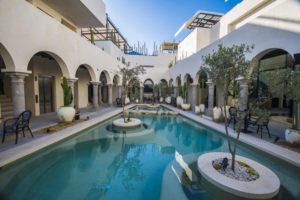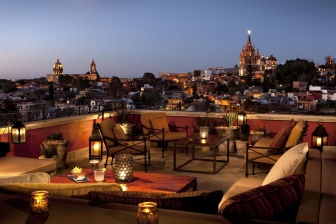What’s Old is New in San Miguel de Allende
News Category: News, Community News, and General Discussion
-
Now a UNESCO World Heritage Site, the bewitching architecture of San Miguel de Allende continues to evolve nearly 500 years after its establishment. As a result, the list of places to stay that speak to the city’s colonial past, updated with a contemporary spin, seemingly never ends.
To first get a sense of that rich (and yes, imperialist) past, start with one of the most photogenic churches in Mexico. Most people don’t know the neo-Gothic Parroquia de San Miguel Arcángel, and even fewer know it was built by Don Zeferino Gutiérrez, a self-taught architect. Taking inspiration from postcards of European cathedrals, he designed this one at the heart of the city near the luscious Jardín.

Amatte is a new wellness-focused hotel that was built around an existing property by Japanese architect Shinji Miyazaki. In January, it opened its doors to those seeking a place to relax using all five senses. El Gran Mueble’s open-air pool area is one of the most attractive features of the three-story hotel, which deftly incorporates the original design with flashes of Japanese wabi-sabi. In addition, the rooftop has bars with stellar views, an omakase experience, and even a sound room for music.
Repurposed just two years ago, the original Casa Hoyos is another historical site that dates back to the Mexican Revolution and is now a stunning boutique hotel. It started as a money exchange founded by Julián Hoyos that later became a “bean bank” that sold grains. Now, the fourth generation of the Hoyos family has reinterpreted the building as contemporary lodging with Andalusian balconies but kept the original counter used in Julián’s bean bank.

Another hotel gem is Casa de Sierra Nevada. With its walkways bordered by lavender bushes, the property is an enchanting hideaway in an already fairy-tale city. The vintage casas and mini-mansions of the complex exude a colonial-baroque charm. Each one houses a modern cultural treasure; there’s a Mexican cooking school called Sazón in one, and an artist’s corner in another where guests can make mojigangas, life-size papier-mâché puppets emblematic of San Miguel.
The Forbes five-star Rosewood is also a must, if only for the panoramic views from its Luna Rooftop Bar, but also for its new summer experiences. A visit to the property’s sustainable farm, Via Orgánica, for Mexican lunch and pulque tasting is available for food lovers, and a bougainvillea workshop in the garden will teach guests how to make skin care products with the Fuschia-colored flowers found all over San Miguel.

For a further sense of the city’s embrace of the past, a visit to Fábrica la Aurora is a must for art lovers. The former textile mill has been refurbished into a multi-use space with galleries and an antique shop. Likewise, the frescoes at another UNESCO World Heritage Site, Santuario de Jesús Nazareno de Atotonilco, are worth a short detour outside of town: They were painted 300 years ago by an Indigenous artist, and the church recently restored them.


Leave a Reply